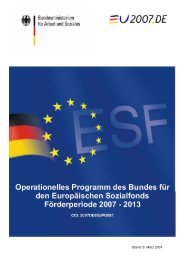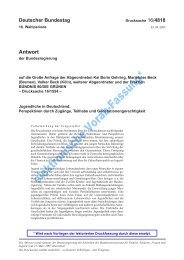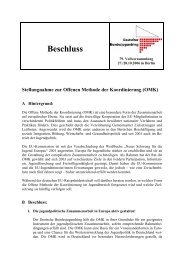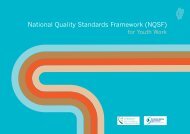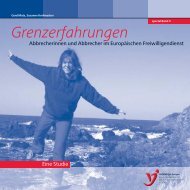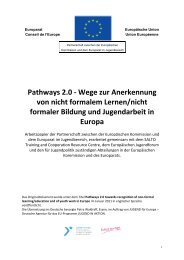6 Country Reports on Youth Work - Jugendpolitik in Europa
6 Country Reports on Youth Work - Jugendpolitik in Europa
6 Country Reports on Youth Work - Jugendpolitik in Europa
You also want an ePaper? Increase the reach of your titles
YUMPU automatically turns print PDFs into web optimized ePapers that Google loves.
Comments:<br />
Differences between nati<strong>on</strong>al and local level<br />
In Spa<strong>in</strong>, much like <strong>in</strong> Greece or the Netherlands, the local survey provided extensive<br />
<strong>in</strong>formati<strong>on</strong> about youth work that was not available at nati<strong>on</strong>al level. First of all it can be<br />
stated that although youth work structures are not well established, there is nevertheless a<br />
wide range of youth work activities. While at nati<strong>on</strong>al level it was <strong>on</strong>ly possible to trace<br />
tra<strong>in</strong><strong>in</strong>g activities for labour market <strong>in</strong>serti<strong>on</strong> and youth <strong>in</strong>formati<strong>on</strong> activities, at local level it<br />
becomes clear that the ma<strong>in</strong> activities provided at this level are extracurricular youth<br />
educati<strong>on</strong>, leisure time and recreati<strong>on</strong>al activities, and that labour market-oriented activities<br />
are not dom<strong>in</strong>at<strong>in</strong>g.<br />
Differences at local level<br />
The activities provided <strong>in</strong> rural areas are scarcer that <strong>in</strong> urban areas, but nevertheless<br />
cultural and recreati<strong>on</strong>al activities, youth associati<strong>on</strong>s, c<strong>on</strong>sultancies for employment issues<br />
and sports are <strong>on</strong> offer. People work<strong>in</strong>g <strong>in</strong> the youth work areas are generally professi<strong>on</strong>als<br />
with higher educati<strong>on</strong> degrees. In associati<strong>on</strong>s there are higher numbers of volunteers than<br />
employed youth workers. The majority of employees and volunteers are women, so that we<br />
can say that youth work <strong>in</strong> Spa<strong>in</strong> is a fem<strong>in</strong>ised professi<strong>on</strong>. The ma<strong>in</strong> target group of youth<br />
work <strong>in</strong> rural areas is the 13- to 19-year-olds, whereas <strong>in</strong> urban areas youth work targets<br />
young people between 15 and 19 years of age.<br />
10.11Comparative Overview of local f<strong>in</strong>d<strong>in</strong>gs<br />
10.11.1 Availability of data<br />
The central result of the present study has been to show that it is <strong>in</strong>deed possible to describe<br />
the structures of youth work at local level. The <strong>in</strong>dicators we had set proved to be suitable <strong>in</strong><br />
all countries except Ireland and Italy, and they <strong>in</strong>deed produced relevant results. We were<br />
unable to obta<strong>in</strong> quantitative data <strong>in</strong> either Ireland or Italy, primarily because of the restricted<br />
timeframe. In these two countries it was particularly difficult to identify the parties and<br />
<strong>in</strong>stituti<strong>on</strong>s <strong>in</strong>volved <strong>in</strong> youth work at local level. The people we manage to c<strong>on</strong>tact had no<br />
exist<strong>in</strong>g <strong>in</strong>formati<strong>on</strong> at their disposal – they would therefore have had to be asked and<br />
encouraged to collect data <strong>in</strong>ternally. In Spa<strong>in</strong> we had to describe <strong>in</strong> detail the fields of<br />
activity of youth work to the <strong>in</strong>stituti<strong>on</strong>s we surveyed. These <strong>in</strong>stituti<strong>on</strong>s were not familiar with<br />
the terms used, even though the activities as such may <strong>in</strong>deed have been offered.<br />
Most of the problems we encountered with regard to data collecti<strong>on</strong> came up when data had<br />
to be obta<strong>in</strong>ed from n<strong>on</strong>-public associati<strong>on</strong>s. As a result of these groups’ volunteer-based<br />
structures, they had to be approached several times before the necessary data was<br />
provided. For Austria this is the reas<strong>on</strong> for the low rate of return – 36% – while for Romania<br />
112



